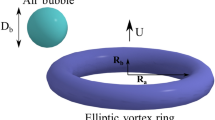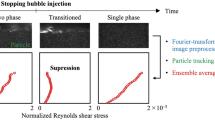Abstract
Injection of bubbles into Taylor–Couette flow creates new flow modes which have not been experienced in single-phase flow conditions. An array of spiral vortices array is one such mode departing from the original toroidal Taylor vortices. The aim of the present study is to explore the mode transition of the two-phase flow using particle tracking velocimetry. Vertical-axis concentric cylinder with a rotating inner cylinder was used to measure the motion of both phases in the range 600 < Re < 4500. From time–space mapping of the experimentally measured stream functions, we found that bubble injection intensified the axial displacement of the wavy Taylor vortices in the toroidal array, and there was a smooth switching to a spiral array when the azimuthal traveling velocities coincided between two phases. During this vortical reconnection, the two counter-rotating vortices were attenuated asymmetrically. After the two phases co-organized a spiral array, the spiral-maintaining mechanism was weakened to restore the toroidal vortices. These forward and backward mode transitions occurred periodically as bubble injection flow rates increased. We, therefore, concluded that modal switching was an evidence of two-way bubble–vortex interaction for a maximized state, causing the largest drag reduction reported in this regime.
Graphical abstract



















Similar content being viewed by others
References
Andereck CD, Liu SS, Swinny HL (1986) Flow regimes in a circular Couette system with independently rotating cylinders. J Fluid Mech 164:155–183
Atkhen K, Fontaine J, Wesfreid JE (2002) Highly turbulent Couette–Taylor bubbly flow patterns. J Fluid Mech 422:55–88
Ceccio S (2010) Frictional drag reduction of external flows with bubble and gas injection. Ann Rev Fluid Mech 42:183–203
Chouippe A, Climent E, Legendre D, Gabillet C (2014) Numerical simulation of bubble dispersion in turbulent Taylor–Couette flow. Phys Fluids 26:043304
Climent E, Simonnet M, Magnaudet J (2007) Preferential accumulation of bubbles in Couette–Taylor flow patterns. Phys Fluids 19:032203
Djeridi H, Gabillet C, Billard JY (2004) Two-phase Couette–Taylor flow: arrangement of the dispersed phase and effects on the flow structure. Phys Fluids 16:128–139
Fokoua GN, Gabillet C, Aubert A, Colin C (2015) Effect of bubble’s arrangement on the viscous torque in bubbly Taylor–Couette flow. Phys Fluids 27:034105
Gao X, Kong B, Vigil RD (2015) CFD investigation of bubble effects on Taylor–Couette flow patterns in the weakly turbulent vortex regime. Chem Eng Sci 270:508–518
Gils DPM, Guzman DN, Sun C, Lohse D (2013) The importance of bubble deformability for strong drag reduction in bubbly turbulent Taylor–Couette flow. J Fluid Mech 722:317–347
Hu H, Wen J, Bao L, Jia L, Song D, Song B, Pan G, Scaraggi M, Dini D, Xue Q, Zhou F (2017) Significant and stable drag reduction with air rings confined by alternated superhydrophobic and hydrophilic stripes. Sci Adv 3:e1603288
Huang J, Murai Y, Yamamoto F (2008) Shallow DOF-based particle tracking velocimetry applied to horizontal bubbly wall turbulence. Flow Meas Instrum 19:93–105
Hubacz R, Wronski S (2004) Horizontal Couette-Taylor flow in a two-phase gas–liquid system: flow patters. Exp Therm Fluid Sci 28:457–472
Ido T, Murai Y (2006) A recursive interpolation algorithm for particle tracking velocimetry. Flow Meas Instrum 17:267–275
Ido T, Murai Y, Yamamoto F (2002) Post-processing algorithm for particle tracking velocimetry based on ellipsoidal equations. Exp Fluids 32:326–336
Kang C, Meyer A, Mutabazi I, Yoshikawa HN (2017) Radial buoyancy effects on momentum and heat transfer in a circular Couette flow. Phys Rev Fluids 2:053901
Kida S, Takaoka M (1994) Vortex reconnection. Ann Rev Fluid Mech 26:169–177
King GP, Lee YLW, Swinney HL, Marcus PS (1984) Wave speeds in wavy Taylor-vortex flow. J Fluid Mech 141:365–390
Majji MV, Morris JF (2018) Inertial migration of particles in Taylor–Couette flows. Phys Fluids 30:033303
Martinand D, Serre E, Lueptow RM (2014) Mechanism for the transition to waviness for Taylor vortices. Phys Fluids 26:094102
Maryami R, Farahat S, Javad poor M, Shafiei Mayam MH (2014) Bubbly drag reduction in a vertical Couette–Taylor system with superimposed axial flow. Fluid Dyn Res 46:055504
Mehel A, Gabillet C, Djeridi H (2007) Analysis of the flow pattern modifications in a bubbly Couette–Taylor flow. Phys Fluids 19:118101
Murai Y (2014) Frictional drag reduction by bubble injection. Exp Fluids 55:1773
Murai Y, Ido T, Yamamoto F (2002) Post-processing method using ellipsoidal equations for PTV measurement results. JSME Int J Ser B 45:142–149
Murai Y, Oiwa H, Takeda Y (2008) Frictional drag reduction in bubbly Couette–Taylor flow. Phys Fluids 20:034101
Murai Y, Shiratori T, Kumagai I, Ruehs PA, Fischer P (2015) Effective viscosity measurement of interfacial bubble and particle layers at high volume fraction. Flow Meas Instrum 41:121–128
Oishi Y, Murai Y (2014) Horizontal turbulent channel flow interacted by a single large bubble. Exp Therm Fluid Sci 55:128–139
Park HJ, Tasaka Y, Oishi Y, Murai Y (2015) Drag reduction promoted by repetitive bubble injection in turbulent channel flows. Int J Multiphase Flow 75:12–25
Rosenberg BH, Buren TV, Fu MK, Smits AJ (2016) Turbulent drag reduction over air- and liquid-impregnated surfaces. Phys Fluids 28:015103
Rust AC, Manga M (2002) Effects of bubble deformation on the viscosity of dilute suspensions. J Non Newtonian Fluid Mech 104:53–63
Shiomi Y, Kutsuna H, Akagawa K, Ozawa M (1993) Two-phase flow in an annulus with a rotating inner cylinder-flow pattern in bubbly flow region. Nucl Eng Des 141:27–34
Spandan V, Ostilla-Mónico R, Verzicco R, Lohse D (2016) Drag reduction in numerical two-phase Taylor–Couette turbulence using Euler–Lagrange approach. J Fluid Mech 798:411–435
Spandan S, verzicco R, Lohse D (2017) Deformable ellipsoidal bubbles in Taylor–Couette flow with enhanced Euler–Lagrangian tracking. Phys Rev Fluids 2:104304
Srinivasan S, Kleingartner JA, Gilbert JB, Cohen RE (2015) Sustainable drag reduction in turbulent Taylor–Couette flows by depositing sprayable superhydrophobic surfaces. Phys Rev Let 114:014501
Sugiyama K, Calzavarini E, Lohse D (2008) Microbubbly drag reduction in Taylor–Couette flow in the wavy vortex regime. J Fluid Mech 608:21–41
Taylor GI (1923) Stability of a viscous liquid contained between two rotating cylinders. Philos Trans R Soc A 223:289–343
van Ruymbeke B, Murai Y, Tasaka Y, Oishi Y, Gabillet C, Colin C, Latrache N (2017) Quantitative visualization of swirl and cloud bubbles in Taylor–Couette flow. J Vis 20:349–358
van den Berg TH, Luther S, Lathrop DP, Lohse D (2005) Drag reduction in bubbly Taylor–Couette turbulence. Phys Rev Lett 94:044501
Watamura T, Tasaka Y, Murai Y (2013) Intensified and attenuated waves in a microbubble Taylor–Couette flow. Phys Fluids 25:054107
Wereley ST, Lueptow RM (1999) Velocity field for Taylor–Couette flow with an axial flow. Phys Fluids 11:3637–3649
Wronski S, Hubacz R, Ryszczuk T (2005) Interfacial area in a reactor with helicoidal flow for the two-phase gas–liquid system. Chem Eng J 105:71–79
Zhao Y, Yang Y, Chen S (2016) Vortex reconnection in the late transition in channel flow. J Fluid Mech 802:R4
Acknowledgements
This study was financially supported by the Japan Society for the Promotion of Science (JSPS KAKENHI no. 17H01245) and technically supported by Mr. Koji Yoshida and Mr. Toshiyuki Sampo, Laboratory for Flow Control, Hokkaido University. We thank Mr. Michael Luetchford, BTech, from Edanz Group (http://www.edanzediting.com/ac), for editing the English text of a draft of this manuscript.
Author information
Authors and Affiliations
Corresponding author
Additional information
Publisher’s Note
Springer Nature remains neutral with regard to jurisdictional claims in published maps and institutional affiliations.
Rights and permissions
About this article
Cite this article
Murai, Y., Tasaka, Y., Oishi, Y. et al. Modal switching of bubbly Taylor–Couette flow investigated by particle tracking velocimetry. Exp Fluids 59, 164 (2018). https://doi.org/10.1007/s00348-018-2620-2
Received:
Revised:
Accepted:
Published:
DOI: https://doi.org/10.1007/s00348-018-2620-2




